Nutritional Deficiencies/Disorders of Potato
Nutritional Deficiencies/Disorders of Potato
Nitrogen
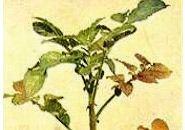 The yellowing in nitrogen deficiency is uniform over the entire leaf including the veins. Recovery of deficient plants to applied nitrogen is immediate (days) and spectacular. Younger leaves turn darker green, older leaves remain yellow. Upward cupping of deficient when severs.
The yellowing in nitrogen deficiency is uniform over the entire leaf including the veins. Recovery of deficient plants to applied nitrogen is immediate (days) and spectacular. Younger leaves turn darker green, older leaves remain yellow. Upward cupping of deficient when severs.
Correction measure: Foliar application of 2% urea thrice at fortnightly interval or soil application of Nitrogen based on soil test recommendation.
Phosphorus
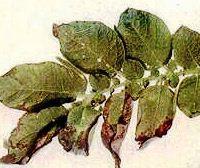 The symptoms first develop on older leaves showing some necrotic spots and plants are dwarfed or stunted. Phosphorus deficient plants develop very slowly. Plants develop a distinct purpling of the stem, petiole and the under sides of the leaves. Plant remains stunted, darker than normal color. Lower leaf surface gray-green. Leaflets roll upward, severely if deficiency is severe.
The symptoms first develop on older leaves showing some necrotic spots and plants are dwarfed or stunted. Phosphorus deficient plants develop very slowly. Plants develop a distinct purpling of the stem, petiole and the under sides of the leaves. Plant remains stunted, darker than normal color. Lower leaf surface gray-green. Leaflets roll upward, severely if deficiency is severe.
Correction measure: Soil application of recommended dose of phosphorous should be applied at the time of sowing or planting.
Potassium
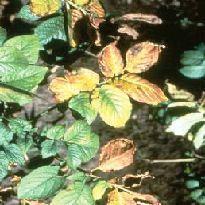 Since potassium is very mobile within the plant, symptoms only develop on young and full sized leaves in the case of extreme deficiency. Leaflets become rugose (crinkled). Some of the leaves show marginal necrosis (tip burn), and at a more advanced deficiency status show interveinal necrosis. As the deficiency progresses, most of the interveinal area becomes necrotic, the veins remain green and the leaves tend to curl and crinkle. Leaves take on a scorched appearance with black pigmentation and necrtic (dead tissue) edges. In contrast to nitrogen deficiency, chlorosis is irreversible in potassium deficiency, even if potassium is given to the plants.
Since potassium is very mobile within the plant, symptoms only develop on young and full sized leaves in the case of extreme deficiency. Leaflets become rugose (crinkled). Some of the leaves show marginal necrosis (tip burn), and at a more advanced deficiency status show interveinal necrosis. As the deficiency progresses, most of the interveinal area becomes necrotic, the veins remain green and the leaves tend to curl and crinkle. Leaves take on a scorched appearance with black pigmentation and necrtic (dead tissue) edges. In contrast to nitrogen deficiency, chlorosis is irreversible in potassium deficiency, even if potassium is given to the plants.
Correction measure: Foliar application of K2SO4 @1%.
Sulfur
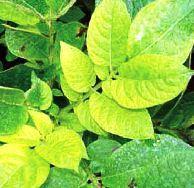 This leaves show a general overall chlorosis. The veins and petioles show a very distinct reddish color. The yellowing is much more uniform over the entire plant including young leaves. The reddish color often found on the underside of the leaves. With advanced sulfur deficiency the leaves tend to become more erect and often twisted and brittle. Leaflet yellowing is uniform and general.
This leaves show a general overall chlorosis. The veins and petioles show a very distinct reddish color. The yellowing is much more uniform over the entire plant including young leaves. The reddish color often found on the underside of the leaves. With advanced sulfur deficiency the leaves tend to become more erect and often twisted and brittle. Leaflet yellowing is uniform and general.
Correction measure: Apply gypsum@ 100 Kg /acre in soil and use sulphur containing fertilizers e.g. SSP. Foliar spray of K2SO4 or CaSO4 @1% twice at fortnightly interval.
Magnesium
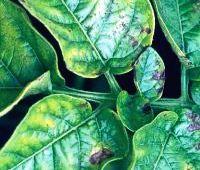 The Mg-deficient leaves show advanced inter veinal chlorosis. Interveinal necrosis causes scorched look. In its advanced form, magnesium deficiency may superficially resemble potassium deficiency. The symptoms generally start with mottled chlorotic areas developing in the interveinal tissue. Symptoms appear first on young mature leaves.
The Mg-deficient leaves show advanced inter veinal chlorosis. Interveinal necrosis causes scorched look. In its advanced form, magnesium deficiency may superficially resemble potassium deficiency. The symptoms generally start with mottled chlorotic areas developing in the interveinal tissue. Symptoms appear first on young mature leaves.
Correction measure: Foliar application of 0.2% MgSO4.
Manganese
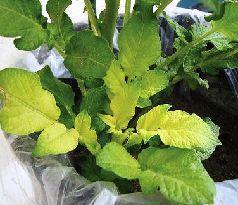 The leaves show a light interveinal chlorosis developed under a limited supply of Mn. The early stages of the chlorosis induced by manganese deficiency are somewhat similar to iron deficiency. As the stress increases, the leaves develop dark necrotic areas along the veins. Leave cup upward. Browing spotting ocurs on leaflets, especially along larger veins and mid-ribs.
The leaves show a light interveinal chlorosis developed under a limited supply of Mn. The early stages of the chlorosis induced by manganese deficiency are somewhat similar to iron deficiency. As the stress increases, the leaves develop dark necrotic areas along the veins. Leave cup upward. Browing spotting ocurs on leaflets, especially along larger veins and mid-ribs.
Correction measure: Spray 0.2 % manganese sulphate 2-3 times at weekly intervals.
Molybdenum
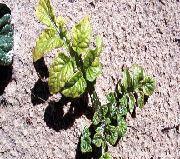 The leaves show some mottled spotting along with some inter veinal chlorosis. An early symptom for molybdenum deficiency is a general overall chlorosis, similar to the symptom for nitrogen deficiency but generally without the reddish coloration on the undersides of the leaves.
The leaves show some mottled spotting along with some inter veinal chlorosis. An early symptom for molybdenum deficiency is a general overall chlorosis, similar to the symptom for nitrogen deficiency but generally without the reddish coloration on the undersides of the leaves.
Correction measure: Foliar spray of NaMO4 0.05% twice at weekly interval.
Zinc
 The leaves show interveinal necrosis. In the early stages of zinc deficiency the younger leaves become yellow and pitting develops in the interveinal upper surfaces of the mature leaves. As the deficiency progress these symptoms develop into an intense interveinal necrosis but the main veins remain green, as in the symptoms of recovering iron deficiency.
The leaves show interveinal necrosis. In the early stages of zinc deficiency the younger leaves become yellow and pitting develops in the interveinal upper surfaces of the mature leaves. As the deficiency progress these symptoms develop into an intense interveinal necrosis but the main veins remain green, as in the symptoms of recovering iron deficiency.
Correction measure: Foliar spray of ZnSO4 @ 0.5%.
Boron
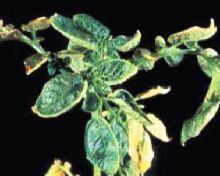 These boron-deficient leaves show a light general chlorosis. Boron deficiency results in necrosis of meristematic tissues in the growing region, leading to loss of apical dominance and the development of a rosette condition. These deficiency symptoms are similar to those caused by calcium deficiency. The leaves are unusually brittle and tend to break easily. Also, there is often a wilting of the younger leaves even under an adequate water supply, pointing to a disruption of water transport caused by boron deficiency.
These boron-deficient leaves show a light general chlorosis. Boron deficiency results in necrosis of meristematic tissues in the growing region, leading to loss of apical dominance and the development of a rosette condition. These deficiency symptoms are similar to those caused by calcium deficiency. The leaves are unusually brittle and tend to break easily. Also, there is often a wilting of the younger leaves even under an adequate water supply, pointing to a disruption of water transport caused by boron deficiency.
Correction measure: Foliar spray of borax @ 0.2%.
Calcium
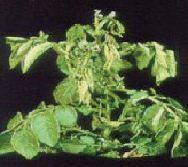 The calcium-deficient leaves show necrosis around the base of the leaves. The very low mobility of calcium is a major factor determining the expression of calcium deficiency symptoms in plants. Symptoms show soft dead necrotic tissue at rapidly growing areas, which is generally related to poor translocation of calcium to the tissue rather than a low external supply of calcium. This ultimately results in the margins of the leaves growing more slowly than the rest of the leaf, causing the leaf to cup downward. Plants under chronic calcium deficiency have a much greater tendency to wilt than non-stressed plants.
The calcium-deficient leaves show necrosis around the base of the leaves. The very low mobility of calcium is a major factor determining the expression of calcium deficiency symptoms in plants. Symptoms show soft dead necrotic tissue at rapidly growing areas, which is generally related to poor translocation of calcium to the tissue rather than a low external supply of calcium. This ultimately results in the margins of the leaves growing more slowly than the rest of the leaf, causing the leaf to cup downward. Plants under chronic calcium deficiency have a much greater tendency to wilt than non-stressed plants.
Correction measure: Foliar spray of 2% Calcium sulphate twice at weekly intervals.
Copper
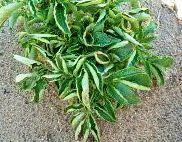 The copper-deficient leaves are curled, and their petioles bend downward. Copper deficiency may be expressed as a light overall chlorosis along with the permanent loss of turgor in the young leaves. Recently matured leaves show netted, green veining with areas bleaching to a whitish gray. Some leaves develop sunken necrotic spots and have a tendency to bend downward.
The copper-deficient leaves are curled, and their petioles bend downward. Copper deficiency may be expressed as a light overall chlorosis along with the permanent loss of turgor in the young leaves. Recently matured leaves show netted, green veining with areas bleaching to a whitish gray. Some leaves develop sunken necrotic spots and have a tendency to bend downward.
Correction measure: Foliar spray of 0.5% CuSO4 twice at fortnightly interval.
Iron
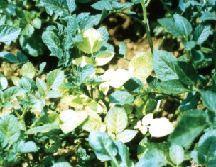 The iron-deficient leaves show strong chlorosis at the base of the leaves with some green netting. The most common symptom for iron deficiency starts out as an interveinal chlorosis of the youngest leaves, evolves into an overall chlorosis, and ends as a totally bleached leaf. Because iron has a low mobility, iron deficiency symptoms appear first on the youngest leaves. Iron deficiency is strongly associated with calcareous soils, anaerobic conditions, and it is often induced by an excess of heavy metals. Growing point and young leaves become yellow or in extreme cases, white. Usually not accompanied by necrosis. Veins and leaflet ends remain green.
The iron-deficient leaves show strong chlorosis at the base of the leaves with some green netting. The most common symptom for iron deficiency starts out as an interveinal chlorosis of the youngest leaves, evolves into an overall chlorosis, and ends as a totally bleached leaf. Because iron has a low mobility, iron deficiency symptoms appear first on the youngest leaves. Iron deficiency is strongly associated with calcareous soils, anaerobic conditions, and it is often induced by an excess of heavy metals. Growing point and young leaves become yellow or in extreme cases, white. Usually not accompanied by necrosis. Veins and leaflet ends remain green.
Correction measure: Soil application of 10 Kg/ acre FeSO4 orspray 0.5% ferrous sulphate solution 2-3 times at weekly intervals.
IPM for Potato
To know the IPM practices for Potato, click here.
Source: NIPHM, and Directorate of Plant Protection, Quarantine & Storage
Last Modified : 7/3/2023
This topic covers the information related to Pest ...
This topic covers the Information related to Crop ...
This topic covers the information related to Insec...
This topic provides information about use of nano ...
